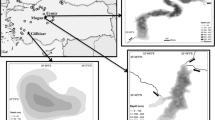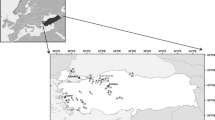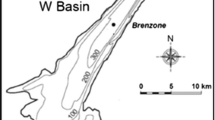Abstract
A study on the taphonomy of Cladocera was carried out in a small (9 ha), oligotrophic mountain loch, Loch Coire Fionnaraich (LCFR) in northwest Scotland. Four approaches were used. First, the fossil assemblage of Cladocera in the core-top sample taken from the deepest basin (14 m) of the loch were compared with the fossil assemblages of Cladocera in surface sediments along eight depth transects with samples taken at 2, 5, 8 and 11 m, respectively. The results of the deposition of remains of individual Cladocera and of the PCA ordination showed that littoral Cladocera were dominant in the 2 m-depth samples, while the planktonic Cladocera dominated the deeper water (8, 11 m and core-top) samples. Second, the fossil assemblages of Cladocera in the core-top sample were compared with the assemblages in a sediment trap sample. The core-top sample showed a better representation of the cladoceran taxa present in the loch than the trap sample, but rare taxa were missing in the core sample. Third, the fossil assemblages of Cladocera in the core sample were compared with the contemporary assemblages in the source samples derived from seasonal sampling across all habitats (macrophyte, sand, boulder) over 2 years. Only a small proportion of Cladocera in the source samples was represented by the fossil assemblages in the core sample. Finally, ‘integrated’ approach samples (spatial, trap, source and core together) were compared using PCA. The Cladocera in the core-top sample were closely related to the trap and surface sediment samples, but weakly related to the source samples. The overall results indicate that biases may occur whilst reconstructing the past environmental change based on the fossil assemblages of Cladocera in the core sample taken from the deepest basin of the lake.







Similar content being viewed by others
References
Alhonen P (1970) On the significance of the planktonic/littoral ratio in the cladoceran stratigraphy of lake sediments. Community Biol 35:1–9
Allan JD (1976) Life history patterns in zooplankton. Am Nat 110:165–180
Ammann B, Birks HJB, Brooks SJ, Eicher U, von Grafenstein U, Hofmann W, Lemdahl G, Schwander J, Tobolski K, Wick L (2000) Quantification of biotic responses to rapid climatic changes around the Younger Dryas—a synthesis. Palaeogeogr Palaeoclimatol Palaeoecol 159:313–347
Battarbee RW (1981) Changes in the diatom microflora of a eutrophic lake since 1900 from a comparison of old algal samples and the sedimentary record. Holarctic Ecol 4:73–81
Battarbee RW, Mackay AW, Jewson DH, Ryves DB, Sturm M (2005) Differential dissolution of Lake Baikal diatoms: correction factors and implications for palaeoclimatic reconstructions. Glob Planet Change 46:75–86
Behrensmeyer AK, Kidwell SM (1985) Taphonomy’s contributions to paleobiology. Paleobiology 11:105–119
Bradbury JP, Winter TC (1976) Areal distribution and stratigraphy of diatoms in the sediments of Lake Sallie, Minnesota. Ecology 57:1005–1014
Branstrator DK (1995) Ecological interactions between Bythotrephes cederstroemi and Leptodora kindtii and the implications for species replacement in Lake Michigan. J Great Lakes Res 21:670–679
Cameron NG (1990) Representation of diatom communities by fossil assemblages in Loch Fleet, Galloway, Scotland. Unpublished Ph.D. thesis, Department of Geography, University College London, 290 pp
Cameron NG (1995) The representation of diatom communities by fossil assemblages in a small acid lake. J Paleolimnol 14:185–223
Catalan J, Ventura M, Brancelj A, Granados I, Thies H, Nickus U, Korhola A, Lotter AF, Barbieri A, Stucklik E, Lien L, Bitusik P, Buchaca T, Camarero L, Goudsmit GH, Kopacek J, Lemcke G, Livingstone DM, Muller B, Rautio M, Sisko M, Sorvari S, Sporka F, Strunecky O, Tori M (2002) Seasonal ecosystem variability in remote mountain lakes: implications for detecting climatic signals in sediment records. J Paleolimnol 28:25–46
Chu G, Liu J, Schettler G, Li J, Sun Q, Gu Z, Lu H, Liu Q, Liu T (2005) Sediment fluxes and varve formation in Sihailongwan, a Marr lake from northeastern China. J Paleolimnol 34:311–324
Chumra GL, Smirnov A, Campbell ID (1999) Pollen transport through distributaries and depositional patterns in coastal waters. Palaeogeogr Palaeoclimatol Palaeoecol 149:257–270
De Nicola DM (1986) The representation of living diatom communities in deep-water sedimentatry diatom assemblages in two Maine (USA) lakes. In: Smol JP, Battarbee RW, Davis RB, Meriläinen J (eds) Diatoms and lake acidity. Dr. W. Junk Publisher, Dordrecht
Efremov JA (1940) Taphonomy: new branch of paleontology. Pan Am Geol 74:81–93
Flöβner D (1972) Krebstiere, Crustacea. Kiemen-und Blattfusser, Branchiopoda, Fischläuse, Branchiura. Die Tierwelt Deutschlands, 501 pp
Frey DG (1960) The ecological significance of cladoceran remains in lake sediments. Ecology 41:684–699
Frey DG (1986) Cladocera analysis. In: Berglund BE (ed) Handbook of Holocene Palaeoecology and Palaeohydrology. John Wiley & Sons Ltd, pp 667–692
Frey DG (1988) Littoral and offshore communities of diatoms, cladocerans and dipterous larvae, and their interpretation in paleolimnology. J Paleolimnol 1:179–191
Fryer G (1974) Evolution and adaptive radiation in the Macrothricidae (Crustacea: Cladocera): a study in comparative functional morphology and ecology. Philos Trans R Soc Lond B Biol Sci 269:134–274
Fryer G (1993) The freshwater Crustacea of Yorkshire a faunistic and ecological survey. Yorkshire Naturalists’ Union and Leeds Philosophical and Literary Society
George DG, Harris GP (1985) The effect of climate on long-term changes in the crustacean zooplankton biomass of Lake Windermere, UK. Nature 316:536–539
George DG, Talling JF, Rigg E (2000). Factors influencing the temporal coherence of five lakes in the English Lake District. Freshw Biol 43:449–461
Hann BJ (1989) Methods in Quaternary ecology. No. 6. Cladocera. Geosci Can 16:17–26
Hofmann W (1978) Analysis of animal microfossils from the Groβer Segeberger (FRG). Arch Hydrobiol 82:316–346
Jones VJ, Flower RJ (1986) Spatial and temporal variability in periphytic diatom communities: palaeoecological significance in an acidified lake. In: Smol JP, Battarbee RW, Davis RB, Meriläinen J, Dordrecht Dr W (eds) Diatom and lake acidity, Junk Publisher, 307 pp
Kato M, Tanimura Y, Matsuoka K, Fukusawa H (2003) Planktonic diatoms from sediment traps in Omura Bay, western Japan with implications for ecological implications for ecological and taphonomic studies of coastal marine environments. Quat Int 105:25–31
Kattel GR (2005) Cladocera in mountain lakes: their potential role in reconstructing climate change. Unpublished PhD thesis, Department of Geography, University College London, 389 pp
Korhola A (1990) Paleolimnology and hydroseral development of the Kotasuo Bog, Southern Finland, with special reference to the Cladocera. Ann Acad Sci Fenn A III 155:1–40
Korhola A (1992) The early Holocene hydrosere in a small acid hill-top basin studied using crustacean sedimentary remains. J Paleolimnol 7:1–22
Korhola A (1999) Distribution patterns of Cladocera in subarctic Fennoscandian lakes and their potential in environmental reconstruction. Ecography 22:357–373
Korhola A, Olander H, Blom T (2000) Cladoceran and chironomid assemblages as quantitative indicators of water depth in subarctic Fennoscandian lakes. J Paleolimnol 24:43–54
Korhola A, Rautio M (2001) Cladocera and other branchipod crustaceans. In: Smol JP, Birks HJB, Last WM (eds) Tracking environmental change using lake sediments, vol 4: zoological indicators. Kluwer Academic Publishers, Dordrecht The Netherlands, 240 pp
Korhola A, Tikkanen M, Weckström J (2005) Quantification of Holocene lake-level changes in Finnish Lapland using a cladocera—lake depth transfer model. J Paleolimnol 34:175–190
Lotter AF, Birks HJB, Eicher U, Hofmann W, Schwander J, Wick L (2000) Younger Dryas and Allerod summer temperatures at Gerzensee (Switzerland) inferred from fossil pollen and cladoceran assemblages. Palaeogeogr Palaeoclimatol Palaeoecol 159:349–361
Mackay AW, Ryves DB, Battarbee RW, Flower RJ, Jewson D, Rioual P, Sturm P (2005) 1000 years of climate variability in central Asia: assessing the evidence using Lake Baikal (Russia) diatom assemblages and the application of a diatom-inferred model of snow cover on the lake. Glob Planet Change 46:281–297
Moos MT, Kathleen R, Laird R, Cumming BF (2005) Diatom assemblages and water depth in Lake 239 (Experimental Lake Area, Ontario): implications for paleoclimatic studies. J Paleolimnol 34:217–227
Müeller WP (1964) The distribution of cladoceran remains in surficial sediments from three Northern Indiana Lakes. Investig Ind Lakes Streams 6:1–63
Nilssen J, Sandøy S (1990) Recent lake acidification and cladoceran dynamics: surface sediment and core analyses from lakes in Norway, Scotland and Sweden. Philos Trans R Soc Lond B Biol Sci 327:299–309
Rautio M, Sorvari S, Korhola A (2000) Diatom and crustacean zooplankton communities, their seasonal variability and representation in the sediments of subarctic Lake Saanajarvi. J Limnol 59:81–96
Ryves DB, Jewson DH, Sturm M, Battarbee RW, Flower RJ, Mackay AW, Granin NG (2003) Quantitative and qualitative relationships between planktonic diatom communities and diatom assemblages in sedimenting material and surface sediments in Lake Baikal, Siberia. Limnol Oceanogr 48:1643–1661
Scourfield DJ, Harding JP (1958) A key to the British Freshwater Cladocera with notes on their ecology. Freshwater Biological Association Scientific Publication, UK
Takashi K, Billings JD, Morgan JK (1990) Oceanic province: assessment from the time series diatom fluxes in the northeastern Pacific. Limnol Oceanogr 35:165
ter Braak CJF, Šmilauer P (2002) CANOCO reference manual and CanoDraw for Window’s User’s guide: software for canonical community ordination (Version 4.5). Microcomputer Power, Ithaca, NY, USA, 500 pp
Whiteside MC (1974) Chydorid (Cladocera) ecology: seasonal patterns and abundance of populations in Elk Lake, Minnesota. Ecology 55:538–550
Whiteside MC, Harmsworth RV (1967) Species diversity in Chydorid (Cladocera) communities. Ecology 48:664–667
Whiteside MC, Swindoll MR (1988) Guidelines and limitations to cladoceran paleoecological interpretations. Palaeogeogr Palaeoclimatol Palaeoecol 62:405–412
Whiteside MC, Williams JB, White CP (1978) Seasonal abundance and pattern of chydorid, Cladocera in mud and vegetative habitats. Ecology 59:1177–1188
Zaret TM, Suffern JS (1976) Vertical migration in zooplankton as a predator avoidance mechanism. Limnol Oceanogr 21:804–813
Acknowledgements
We are grateful to members of the Environmental Change Research Centre (ECRC), University College London (UCL), for their invaluable support for this work both in the field and in the laboratory. We would also like to thank two anonymous reviewers as well as the co-editor-in-chief of JOPL, John Smol, which helped us to improve the quality of this manuscript significantly. This work was funded by an ORS Award to Giri Kattel, the UCL Department of Geography, ENSIS Ltd and a UCL Graduate School Research Scholarship.
Author information
Authors and Affiliations
Corresponding author
Appendix 1
Appendix 1
Rights and permissions
About this article
Cite this article
Kattel, G.R., Battarbee, R.W., Mackay, A. et al. Are cladoceran fossils in lake sediment samples a biased reflection of the communities from which they are derived?. J Paleolimnol 38, 157–181 (2007). https://doi.org/10.1007/s10933-006-9073-y
Received:
Accepted:
Published:
Issue Date:
DOI: https://doi.org/10.1007/s10933-006-9073-y




